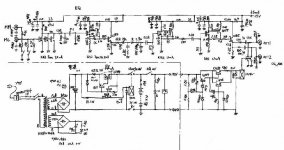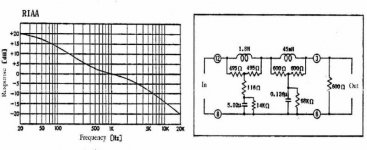Hi,
glanced at LCR with tubes
I have an existing breadborddesign of le pacific, and I'm wondering how to integrate a LCR-RIAA as a try-out.
I want to avoid 1) interstage transformer, 2) large coupling cap's.
So I guess I need an additional stage to drive the 600Ohm load of the LCR. I'm not a smart designer, so maybe someone has a few hints?
have fun,
Rudiger
glanced at LCR with tubes
I have an existing breadborddesign of le pacific, and I'm wondering how to integrate a LCR-RIAA as a try-out.
I want to avoid 1) interstage transformer, 2) large coupling cap's.
So I guess I need an additional stage to drive the 600Ohm load of the LCR. I'm not a smart designer, so maybe someone has a few hints?
have fun,
Rudiger
LCR
Hi Rudiger,
This was done with FETs before by some Japanese audio guys...maybe even Kaneda.
I must have details on that somewhere in my library, the only trouble is the FETs will likely be obsolete or tough to come by.
The good news is it shouldn't be too hard to accomplish a 600 Ohm Zo with FETs.
The bad news is...I don't know enoogh about them to help you.
Surely some members should though.😉
Hi Rudiger,
This was done with FETs before by some Japanese audio guys...maybe even Kaneda.
I must have details on that somewhere in my library, the only trouble is the FETs will likely be obsolete or tough to come by.
The good news is it shouldn't be too hard to accomplish a 600 Ohm Zo with FETs.
The bad news is...I don't know enoogh about them to help you.
Surely some members should though.😉
Just curious if you already have the LCR modules or not. If not you'll be free to use other impedances than 600ohms. A simple way to drive the LCR modules will be through bipolar cathode followers after the fets in your riaa.
cheers
peter
cheers
peter
Hi Peter,
I'm only testing; I bought cheap cores and made my own coils. (1.8H and 45mH). The parts are here, so I'd like to use them...
Rüdiger
I'm only testing; I bought cheap cores and made my own coils. (1.8H and 45mH). The parts are here, so I'd like to use them...
Rüdiger
Hi onvinyl,
yes you have to put in an impedance converter with bipolar or with fet to drive the lcr riaa.But you need a big cap after the follower to get the right 20 Hz
yes you have to put in an impedance converter with bipolar or with fet to drive the lcr riaa.But you need a big cap after the follower to get the right 20 Hz
Hi hsort,
well, ok. But how? I have +24V U, fets handy are 2sk170.
It should not be though to make, but I have no idea
It seems, Hiraga described a circuit in L'Audiophile No. 39, but all I can find in the net concerns the LCR-circuit only.
Rüdiger
well, ok. But how? I have +24V U, fets handy are 2sk170.
It should not be though to make, but I have no idea

It seems, Hiraga described a circuit in L'Audiophile No. 39, but all I can find in the net concerns the LCR-circuit only.
Rüdiger
Hi Rüdiger,
with sk 170: g to d(first amp),d to vcc,s in series with 600 Ohm to Ground,to couple to the lrc stage with 47 U from s ok ?
with sk 170: g to d(first amp),d to vcc,s in series with 600 Ohm to Ground,to couple to the lrc stage with 47 U from s ok ?
Hi,
I'll try and report later. May take some days...
thanx a lot!
Rüdiger
easy enough 🙂with sk 170: g to d(first amp),d to vcc,s in series with 600 Ohm to Ground,to couple to the lrc stage with 47 U from s ok ?
I'll try and report later. May take some days...
thanx a lot!
Rüdiger
Hi,
made a first test yesterday. Just opened the existing circuit, connected to the suggested impedance converter, through the LCR and back to existing circuit.
Partly, it works. But it seems like i get too much treble/not enough dampening of trebles. If I change the original 0.12uF cap to 0.270uF, tonality comes back, but still too much treble (i can tell cause i just changed one channel).
I'm not able to calculate the LCR, which choke(s) may be wrong? I cannot measure the inductance, with DC the 1.8H ones have 70 Ohms, the small ones 4-5 OHms.
Any hints?
Rüdiger
made a first test yesterday. Just opened the existing circuit, connected to the suggested impedance converter, through the LCR and back to existing circuit.
Partly, it works. But it seems like i get too much treble/not enough dampening of trebles. If I change the original 0.12uF cap to 0.270uF, tonality comes back, but still too much treble (i can tell cause i just changed one channel).
I'm not able to calculate the LCR, which choke(s) may be wrong? I cannot measure the inductance, with DC the 1.8H ones have 70 Ohms, the small ones 4-5 OHms.
Any hints?
Rüdiger
If you can't measure inductance your only sensible option is to measure the overall gain and compare it to riaa curve. You can either build an inverted riaa (not really an option if you don't have precise components or abilty to measure with high accuracy) or take down the gain for a number of frequencies and compare to riaa. The simplest option is to use your sound card as both signal source and measurement device. Depending on the quality of the SC you'll probably get better than 1db readings.
cheers
peter
cheers
peter
Hi,
this is the +/- 0.2dB version, i have at the moment the +/- 0.4dB version (See here...)
Yes, I have 600 Ohms at the end. The output impedance of the converter is around 600 Ohms as well (see prev. postings). If I leave out that res at the end, I get pure distortion (hard to guess the original signal).
Seems I don't understand most interchange- and sideeffects here...
Rüdiger
this is the +/- 0.2dB version, i have at the moment the +/- 0.4dB version (See here...)
Yes, I have 600 Ohms at the end. The output impedance of the converter is around 600 Ohms as well (see prev. postings). If I leave out that res at the end, I get pure distortion (hard to guess the original signal).
Seems I don't understand most interchange- and sideeffects here...
Rüdiger
Koinichiwa,
Well, when I was working with JB from S&B to develop a 600 ohm RIAA based on the Tango design (this is now released BTW and available from the distributors) we found that "normal" chokes had way too much variation of inductance with signal levels and also too much shunt capacitance.
It took quite a surpreme effort to come up with chokes that had a VERY HIGH self resoance frequency (way above the audio band) AND constant inductance with Level AND used high grade core materials.
Our final RIAA manages +/-0.5db overall and very close to +/-0db between 100Hz and 10KHz and does so when I measured over around 60db dynamic range (at least). It took many rounds of winding chokes using different cores and different construction to achieve this.
LCR RIAA EQ's in DIY are nothing for the fainthearted and definitly NOT for those without a serious measurement park. You need to compare to the RIAA curve at each step and at many different levls, plus you need an inductance bridge and the ability to measure the self resonance of the choke.
Sayonara
Onvinyl said:But it seems like i get too much treble/not enough dampening of trebles. If I change the original 0.12uF cap to 0.270uF, tonality comes back, but still too much treble (i can tell cause i just changed one channel).
I'm not able to calculate the LCR, which choke(s) may be wrong? I cannot measure the inductance, with DC the 1.8H ones have 70 Ohms, the small ones 4-5 OHms.
Any hints?
Well, when I was working with JB from S&B to develop a 600 ohm RIAA based on the Tango design (this is now released BTW and available from the distributors) we found that "normal" chokes had way too much variation of inductance with signal levels and also too much shunt capacitance.
It took quite a surpreme effort to come up with chokes that had a VERY HIGH self resoance frequency (way above the audio band) AND constant inductance with Level AND used high grade core materials.
Our final RIAA manages +/-0.5db overall and very close to +/-0db between 100Hz and 10KHz and does so when I measured over around 60db dynamic range (at least). It took many rounds of winding chokes using different cores and different construction to achieve this.
LCR RIAA EQ's in DIY are nothing for the fainthearted and definitly NOT for those without a serious measurement park. You need to compare to the RIAA curve at each step and at many different levls, plus you need an inductance bridge and the ability to measure the self resonance of the choke.
Sayonara
- Status
- Not open for further replies.
- Home
- Source & Line
- Analogue Source
- fet-riaa with LCR?

